
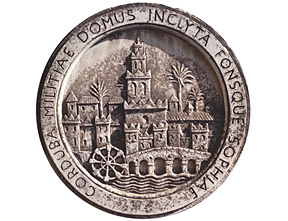 TOR EIGELAND
TOR EIGELAND |
 |
DICK DOUGHTY
The Albolafia noria, or waterwheel, is the last vestige of an array of mills and dams built on the Guadalquivir River in Córdoba between the eighth and 10th centuries. It appears on this carved-stone seal of the city, top, and in its present condition, above. |
Written by Richard Covington
 atch your step!” warns Pedro Marfil. As we gingerly pick our way across the slate rooftop of Córdoba’s eighth-century Mezquita (Spanish for “mosque”), the medieval archeologist does not have to warn me twice. So what if we are a mere 21 meters (70') in the air? It’s still a dizzying drop, made more so by the broiling July sun. With each step, I hear the disconcerting squelch of sandal-sole rubber melting underfoot in the 44-degree (112° F) heat. I think longingly of the cool, dark interior below, with its pillared forest of double-tiered red-and-white striped arches.
atch your step!” warns Pedro Marfil. As we gingerly pick our way across the slate rooftop of Córdoba’s eighth-century Mezquita (Spanish for “mosque”), the medieval archeologist does not have to warn me twice. So what if we are a mere 21 meters (70') in the air? It’s still a dizzying drop, made more so by the broiling July sun. With each step, I hear the disconcerting squelch of sandal-sole rubber melting underfoot in the 44-degree (112° F) heat. I think longingly of the cool, dark interior below, with its pillared forest of double-tiered red-and-white striped arches.
But Marfil is showing me the ingenious grid of gutters, pipes and miniature aqueducts once used to capture precious rainfall and channel it to giant cisterns (aljibes in Spanish; jubb in Arabic) beneath the patio below. From the Middle Ages until the 1950’s, the patio was a cemetery, the derelict cisterns were filled with bones, and the runoff fed the fountains, he says. Now the patio’s well-ordered grove of cinnamon, orange, olive, palm and cypress trees has been restored to the glory it originally enjoyed under the Umayyad rulers, and the cisterns once again collect water for use in the Mezquita. Up on the roof, on this blast furnace of a day, it is perfect weather for appreciating the historic Arab skill of trapping, storing and managing that evanescent, life-giving commodity, water.
Gesturing toward a towering wooden waterwheel a few hundred meters away along the broad Guadalquivir River, Marfil explains that it’s the ruined Albolafia noria, among the last vestiges of the masterful panoply of mills, dams, flood protection and canals that the Umayyads built between the eighth and 10th centuries. (The name of the river comes from the Arabic al-wadi al-kabir, “great river.”) Barely visible in the shallows are also the remnants of an imposing dam, a nearly three-meter-thick (10') barrier built of stone imported from North Africa and marble columns that once rose three meters above the waterline. In the Islamic era, when the mills were in operation, trip-hammers attached to the axles of water-wheels pounded out paper pulp, husked rice and crushed sugarcane in a process imported from China.
Peering down the narrow street between the Mezquita and its neighbor, the Alcázar, a palace converted into a museum, Marfil traces the former path of an aqueduct, now long gone, erected on Roman foundations by ninth-century Caliph Abd al-Rahman ii to bring spring water from the Sierra Morena range, 80 kilometers (50 mi) west. By the 10th century, at a time when no city in western Christendom was larger than 10,000 souls, Córdoba boasted a cosmopolitan population of half a million, sustained by one of the most advanced water systems in the world.
Seven kilometers (4.4 mi) west of the city, among the sprawling ruins of Madinat al-Zahara, the garden capital built by Abd al-Rahman III, archeologists have uncovered evidence of a staggering 300 baths—many lavishly painted—as well as artificial fishponds, sculpted marble pools and basins fed by a network of aqueducts and subterranean canals.
 |
DICK DOUGHTY
Gravity-fed fountains embellish a courtyard at the heart of the Alhambra’s sprawling, elaborate Generalife Gardens in Granada.
|
 rom the ninth through the 16th centuries, Islamic societies from Spain to Oman experienced a “golden age” of science and technology. One of the most important of these technologies is also today one of the least thoroughly studied: hydrology, or the control of the movement of water. The rise of cities like Córdoba, Damascus, Baghdad, Fez and Marrakech all required increasingly sophisticated methods of water management to supply rapidly growing populations. Integrating, adapting and refining irrigation techniques and water distribution methods from India, Asia and Rome, Muslim water engineers, starting as early as the seventh century in Arab countries and around the 10th century in Spain, built an agricultural revolution. Unified by a common language, these Arabic-speaking scientific pioneers sowed their expertise from East to West, and their inventive solutions to the challenges of widely varied terrain underpinned the unprecedented prosperity of the era, says Mohammad El Faïz, an economics historian at Cadi Ayyad University in Marrakech.
rom the ninth through the 16th centuries, Islamic societies from Spain to Oman experienced a “golden age” of science and technology. One of the most important of these technologies is also today one of the least thoroughly studied: hydrology, or the control of the movement of water. The rise of cities like Córdoba, Damascus, Baghdad, Fez and Marrakech all required increasingly sophisticated methods of water management to supply rapidly growing populations. Integrating, adapting and refining irrigation techniques and water distribution methods from India, Asia and Rome, Muslim water engineers, starting as early as the seventh century in Arab countries and around the 10th century in Spain, built an agricultural revolution. Unified by a common language, these Arabic-speaking scientific pioneers sowed their expertise from East to West, and their inventive solutions to the challenges of widely varied terrain underpinned the unprecedented prosperity of the era, says Mohammad El Faïz, an economics historian at Cadi Ayyad University in Marrakech.
One of the earliest Arabic texts explaining how to locate aquifers, dig survey wells and build underground canals, Anabat al-Miya al-Khofia (The Extraction of Hidden Waters to the Surface) was written in Baghdad in the 10th century by the Persian mathematician Muhammad al-Karaji. Meanwhile, physician-philosopher Ibn Sina (Avicenna), who lived primarily in Isfahan and Hamadan between 980 and 1037, established hydraulics as an independent discipline on a par with geometry and astronomy.
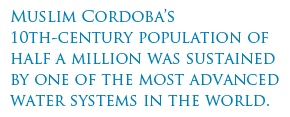 The methodology, machines and discoveries surrounding water had far-reaching impacts not only on agriculture, but also on science, law and social organization—both across the Arab empire and beyond, across the Atlantic. According to Ahmad Hassan of Aleppo University and the late British scholar Donald Hill in their classic 1986 analysis, Islamic Technology, “Muslim irrigation systems with their associated hydraulic works and water-raising machines remained the basis for Spanish agriculture and were transferred to the New World.” After the 15th century, Arab-inspired techniques were adopted in the Canary Islands and as far away as Texas and Louisiana, partly to irrigate thirsty sugarcane fields, explains Antonio Malpica, a professor of medieval history at the University of Granada and an expert on Islamic technology in Spain. In France, he adds, Provençal engineers in the 11th to 13th centuries copied Islamic irrigation networks, and some of them are still in use today.
The methodology, machines and discoveries surrounding water had far-reaching impacts not only on agriculture, but also on science, law and social organization—both across the Arab empire and beyond, across the Atlantic. According to Ahmad Hassan of Aleppo University and the late British scholar Donald Hill in their classic 1986 analysis, Islamic Technology, “Muslim irrigation systems with their associated hydraulic works and water-raising machines remained the basis for Spanish agriculture and were transferred to the New World.” After the 15th century, Arab-inspired techniques were adopted in the Canary Islands and as far away as Texas and Louisiana, partly to irrigate thirsty sugarcane fields, explains Antonio Malpica, a professor of medieval history at the University of Granada and an expert on Islamic technology in Spain. In France, he adds, Provençal engineers in the 11th to 13th centuries copied Islamic irrigation networks, and some of them are still in use today.
 |
TOR EIGELAND
In Iran, excavation spoil rings the entrances of the numerous vertical shafts that allowed for safe digging and periodic cleaning of the underground canals known as qanats.
|
This quantum leap of experimentation shook the Islamic world. In Diyarbakir in upper Mesopotamia (now in present-day Turkey), the 13th-century engineer al-Jazari designed astonishing hydraulic pumps and ingenious water clocks based on principles so advanced they would not be seen in the West for another 300 years, when Leonardo da Vinci and other Italian inventors copied them. Hassan and Hill note that some are regarded as precursors of the first steam and internal-combustion engines.
In Iran, North Africa and Spain, subterranean canals equipped with a series of ventilating shafts leading to the surface were built to extend 20 kilometers (12 mi) or more. Like more basic devices, they had existed for centuries before Islamic civilization adopted and refined them: According to historian Charles Singer, they were carried from Armenia to Persia around the sixth century bc, and from there spread west to Egypt and across North Africa to Morocco. Malpica observed that the Arabs preferred to irrigate by canals from underground springs because—unlike rivers, which often dried up in the summer—the water was available year-round.
Islamic engineers used astrolabes, spherical and plane trigonometry, and complex surveying techniques to lay out the canals and to site dams, many of which were built so solidly they have endured into modern times. In Saudi Arabia, for example, about one-third of the dams constructed in the seventh and eighth centuries are still intact, according to Dutch historian Nicholas Schnitter. In the Spanish province of Valencia, eight 10th-century Muslim dams spanning the Turia River still supply much of the region’s irrigation needs. Elsewhere in the former al-Andalus (the Arab name for the southern Iberian peninsula), Syrian immigrants dammed rivers from the Ebro in the north, near Zaragoza, to Córdoba’s Guadalquivir in their attempts to replicate the perfumed gardens of the Ghuta oasis of Damascus.
 Water projects frequently attained proportions not seen since such great Roman works as the 100-kilometer (62-mi) aqueduct from the Eifel Mountains to Cologne. In the 10th century, the chief hydraulic engineer of Merv (now in Turkmenistan) commanded 10,000 workers who built and maintained irrigation canals and dams, and the resulting series of 10 norias and attached mills stands out today as one of the hydrological wonders of the country.
Water projects frequently attained proportions not seen since such great Roman works as the 100-kilometer (62-mi) aqueduct from the Eifel Mountains to Cologne. In the 10th century, the chief hydraulic engineer of Merv (now in Turkmenistan) commanded 10,000 workers who built and maintained irrigation canals and dams, and the resulting series of 10 norias and attached mills stands out today as one of the hydrological wonders of the country.
Earlier, in the ninth century, Zubayda, wife of the Abbasid caliph Harun al-Rashid, created a series of wells, reservoirs and artificial pools that provided water for pilgrims all along the route from Baghdad to Makkah. The route has been called Darb Zubayda (“Zubayda’s Way”) ever since. A century later, enormous floating mills, built of teak and iron, were moored midstream in the Tigris and Euphrates rivers to take advantage of the constant current to grind up to 10 tons of corn a day.
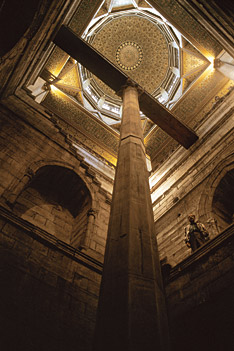 |
BILL HOCKER
In Cairo, the most elaborate of the “nilometers”—instruments which measured the height of the river’s all-important annual flood—was built in 870; it served until the 20th century.
|
Such scale was not, however, without pre-Islamic antecedents: At Marib in Yemen, one colossal project in the seventh century BC raised a dam 600 meters long and 14 meters tall (1950' by 45'), flanked by sluices, spillways, a settling tank and a distribution tank. This technological marvel of the ancient world functioned for a thousand years, then collapsed and was rebuilt twice, and finally collapsed a third time, after which its Himyarite engineers lacked the ability to reconstruct it.
All this water management led to the creation of law: Many fundamental tenets of civil and property law across the Islamic world originated in the contentious give-and-take process of establishing water rights. An early example is the Kitab al-Qina, a code regulating water distribution drawn up by Ibn Tahir, the ninth-century governor of Khurasan province in Iran.
“Water tribunals are a much-neglected aspect of Arab civilization,” El Faïz points out, “even though they frequently served as models for social organization.” In a tradition harking back to Islamic rule, one of these tribunals continues today, in Valencia, where elected representatives of the Andalusian province’s eight irrigation grids gather outside the city’s cathedral every Thursday to share out water and settle disputes.
Although peasants and farmers generally managed smaller installations, major waterworks came under government control. Under the Ayyubids and Mamluks, sultans and large landholders took responsibility for digging and cleaning canals and maintaining dams, according to Salah Zaimeche, an Algerian-born historian of science at Manchester University’s School of Environment and Development in the uk.
Charles Singer, a pioneering Oxford professor of the history of science and the author of a landmark five-volume survey of technology, was one of the first western scholars to acknowledge Arab scientific primacy in the Middle Ages. Writing nearly 50 years ago, Singer contended that during most of the period from 500 to 1500, “technologically, the West had little to bring to the East. The technological movement was in the other direction.” Hill pointed out that a crucial portion of this scientific edge lay in water management, where curved dams, desilting sluices and hydropower were all Muslim inventions.
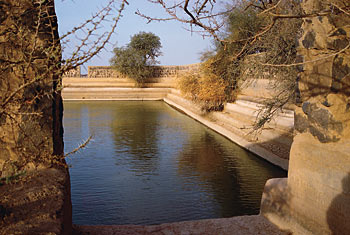 |
PATRICIA BARBOR
One of dozens of rest and water stations on the pilgrim road from Iraq
to Makkah, this pool at Aqiq, Saudi Arabia, still holds water more than a thousand years after it was constructed under the patronage of Zubaydah, the wife of caliph Harun al-Rashid.
|
And although Singer’s and Hill’s views are increasingly part of an emerging historical consensus, there remains a long-standing ignorance obscuring Arab scientific achievements that is particularly acute when it comes to water. “Many historians still believe that nothing important in hydraulic engineering occurred between the fall of the Roman Empire in the fifth century and the beginning of the Renaissance in the 15th century,” grouses El Faïz. Counterarguments from prominent scholars such as Lynn White Jr. of the University of California at Los Angeles and the late Jean Gimpel have largely dismissed Islamic contributions to science and insisted that most Arab technology was either imported from China and India or imitated from Greek and Roman models.
Zaimeche counters that while the Romans left aqueducts, dams and other hydraulic works in Spain and North Africa, most were close to ruin, and the Muslims brought more elaborate and efficient techniques.
Malpica points out that where the Romans ordered their troops to erect stone aqueducts and other massive structures, Muslim projects were typically undertaken by ordinary farmers. “It was Arab peasants who designed and built these systems, not soldiers,” he says. “There were some specialists for large constructions like the Alhambra, but in general, everyone was familiar with the way irrigation worked.”
This was, he explains, less intrusive, even eco-friendly. “The Moorish peasants found smaller solutions that were largely hidden, subtly transforming the landscape without moving great amounts of terrain,” the Granada professor continues. “If you create a qanat, there’s still a lot of vegetation around what is in effect a small stream.” It was not at all the same scale of engineering required for a stone aqueduct to cross, for example, the 800-meter-long (2625') chasm in Segovia, he explains.
This leaves Islamic hydraulic technology largely a terra incognita in the West. Despite the existence of books and sources on the subject in Arabic and Spanish, only a handful have appeared in English and French. Miraculously, a number of key tracts by Arab scholars from the sixth to the 12th centuries that were translated into Latin survived the destruction of Islamic texts and libraries during the Spanish Inquisition. A number of these documents now belong to the Biblioteca Nacional in Madrid.
 |
PATRICIA BARBOR
Built to impound floodwaters in northwestern Saudi Arabia, the Sadd Qasr al-Bint dam was one of numerous engineering projects throughout the Arabian Peninsula.
|
In one pivotal Spanish-language manuscript, the 16th-century Libro di Agricultura, author Gabriel Alonso Herrera passes on essential Arab knowledge about farming and irrigation in Spain. Books by al-Jazari and other medieval Islamic inventors are preserved in the Topkapı Library in Istanbul.
Scholars speculate that there may be further undiscovered knowledge of Muslim technology in general and hydraulic sciences in particular among the thousands of Arabic manuscripts lying untranslated and often uncatalogued in European and North American libraries. Before his death in 1994, Hill advised researchers to probe more deeply into historical material from Spain, Sicily, Syria and Byzantium to better trace the transmission of technologies from Islamic societies to the West.
|
|
 The Shaduf The Shaduf
One of the oldest known tools used to raise water from a well, river or lake is the shaduf. This simple mechanism, used since pharaonic and classical times, consists of a bucket attached to a rope at the long end of a wooden pole. The pole rests on a fulcrum with a counterweight at the short end of the pole. When an operator pulls down the long end of the pole, he lowers the bucket into the source, and the counterweight hauls the full pail back up to the surface. Shadufs were introduced in Spain in the sixth century of our era, but not until the 14th century did they spread north to Germany. They also were adopted in Flanders (in present-day Belgium), where the 16th-century artist Pieter Bruegel the Elder depicted them in engravings of Flemish farms. Although they have largely disappeared from northern Europe, shadufs remain widespread throughout the Middle East, notably along the Nile.
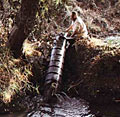 Archimedes Screw Archimedes Screw
This classical device, named for the third-century BC Greek mathematician who first documented it, is composed of a wooden screw mounted inside an inclined cylinder. As the screw is turned, the spiral thread lifts the water into a sluice. Writing around 20 bc, the Greek historian Strabo described just such an Archimedes screw raising water from the Nile.
 The Noria The Noria
Rotated by water-power, noria waterwheels, such as the Albolafia in Córdoba, turned first in Iran, where al-Muqaddasi described numerous norias along the Ahwaz River around the year 1000. Later, the noria became a mainstay of irrigation throughout al-Andalus. Still today in Syria, the city of Hama’s 20-meter-diameter (64') wheel, equipped with 120 compartments that empty into a stone aqueduct, lingers as a nostalgic landmark alongside the Orontes River. Writing in 1154, the geographer al-Idrisi marveled over an Andalusian noria twice that size that lifted water from the Tagus River to Talavera de la Reina near Toledo.
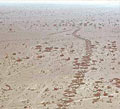 The Qanat The Qanat
One of the most basic methods of controlling and moving water is the canal. When constructed above ground level, a canal is called an aqueduct; when buried below ground level, it may be called a qanat (in Iran), a falaj (in Oman), foggara (in the Sahara regions) or khettara (in Morocco). The oldest qanat may be one uncovered by the 2003 earthquake in Bam, Iran, that dates back more than 2000 years.
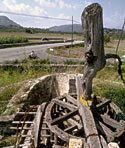 The Saqiya The Saqiya
Originating in Persia around the same time as the qanat, the saqiya is an animal-powered mechanism of interlocking wooden gears, usually two, set at right angles to each other. A donkey or mule is harnessed to a pole fixed to the broad, horizontal wheel, which is set with posts generally less than a meter tall—the teeth of that gear. These posts mesh at right angles with thick pins set into a vertical waterwheel, the second gear. Attached around the circumference of the vertical wheel are clay pots. When the animal walks in a circle, rotating the horizontal wheel, it rotates the vertical wheel, which dips the pots into the water one by one. As each pot reaches the top of its arc, its water pours into a wooden sluice. According to historian Ibn Bassal, the saqiya was the most widely used method of irrigation in the Muslim world by the 11th century.
FROM TOP : SHADUF, SAQIYA, QANAT: TOR EIGELAND; ARCHIMEDES SCREW: SUSAN SHEARS; NORIA: NIK WHEELER |
 fter half a millennium or more, many proudly engineered feats from Spain to Iran and Oman are in various stages of repair. Some, like Granada’s Alhambra, constructed in the 13th and 14th centuries, are splendidly preserved; others are in ruins.
fter half a millennium or more, many proudly engineered feats from Spain to Iran and Oman are in various stages of repair. Some, like Granada’s Alhambra, constructed in the 13th and 14th centuries, are splendidly preserved; others are in ruins.
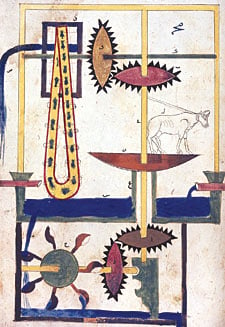 |
PHOTOS12.COM / ORONOZ / TOPKAPI LIBRARY
Though al-Jazari built this water-raising machine as a decorative and mystifying attraction—the machinery in the lower level was hidden from viewers and the cow was a wooden dummy—it was nonetheless an entirely practical design, one of more than 50 hydro-automata he devised. Powered either by a real cow or by the scoop-wheel in the lower level, the upper horizontal axle drove the yellow belt with its attached water-pots to lift water to the upper level.
|
Threaded by gravity-fed canals supplied by a reservoir of water raised from the Darro River, the Alhambra’s gardens, called the Generalife, are without peer, embodying the Islamic visionary ideal of technology and aesthetics at its apex. The gardens’ ornamental pools (birka in Arabic), basins and fountains are surrounded by stately cypresses and flowering tropical plants, all impeccably maintained for the 2.5 million visitors who stream through the site each year, making it, with the Alhambra, one of the most popular tourist sites in Europe.
South across the Mediterranean, in the midst of the Algerian Sahara, the red-clay oasis of Timimoun has evolved around a human-made wetland irrigated by foggaras, an eighth-century labyrinth of channels and storage chambers built 10 to 15 meters (32'–48') below ground to minimize evaporation—much like the qanats farther east. Thanks to this system, farmers to this day grow 100 varieties of date palms—600,000 trees total—across some 25,000 hectares (62,750 acres) of this flourishing oasis, which also produces carrots, onions, fruits and other crops. Similarly, in Morocco, in the eastern desert region of Tafilalt, the landscape is crisscrossed with long, low ridges of earth, looking as if gargantuan moles have been at work. This 300-kilometer (185-mi) web of underground irrigation channels, here called khettaras, was built in the 14th century to tap into the aquifers fed by springs in the High Atlas mountains.
In neighboring Tunisia, a mammoth pair of walled cisterns—the larger one the size of a football field and eight meters (26') deep—diverts water from the Wadi Marj al-Lil near Kairouan and transfers it into irrigation canals. According to Zaimeche, these constructions were originally credited to Phoenician or Roman builders, but were actually devised by Muslim engineers in the ninth century.
 In Egypt, “nilometers” had been used since pharaonic times to measure the height of the Nile’s annual flood, but the most scientifically accurate one was built around 870 by the astronomer Alfraganus; it was used to gauge river levels until modern days. Positioned on the southern tip of Rhoda (Rawdhah) Island near Cairo, it is a domed stone edifice sunk more than 10 meters (32') into the riverbank. Three tunnels, placed at varying heights, connect it to the river. As the river rose, the water also rose inside the structure, and its height was measured on a calibrated, 9.5-meter (30') column. Used to calculate taxes and reckon water distribution, this nilometer and its predecessors have left a nearly unbroken hydrological record dating back to the early seventh century.
In Egypt, “nilometers” had been used since pharaonic times to measure the height of the Nile’s annual flood, but the most scientifically accurate one was built around 870 by the astronomer Alfraganus; it was used to gauge river levels until modern days. Positioned on the southern tip of Rhoda (Rawdhah) Island near Cairo, it is a domed stone edifice sunk more than 10 meters (32') into the riverbank. Three tunnels, placed at varying heights, connect it to the river. As the river rose, the water also rose inside the structure, and its height was measured on a calibrated, 9.5-meter (30') column. Used to calculate taxes and reckon water distribution, this nilometer and its predecessors have left a nearly unbroken hydrological record dating back to the early seventh century.
Continuing east to central Iran, a series of brick domes and wind towers poke distinctively above the skyline of the city of Yazd, indicating the presence of subterranean reservoirs called ab anbars. Relatively late constructions of the Safavid and Qajar eras in the 18th century, these buried pools, some 10 meters (32') below surface level, keep water cool by means of vented towers that circulate in fresh air from the outside, both by capturing breezes and by natural convection over the cool water surface. Some of the grander ab anbars include public baths, shops and coffeehouses. Although there are between 75 and 90 surviving ab anbars in the Yazd region, most are in a precarious state, and a number are on the verge of collapse.
 |
PHOTOS12.COM / ORONOZ / TOPKAPI LIBRARY
With this design, here sketched schematically after an original in the collection of the Topkapı Library in Istanbul, historians Donald Hill and Ahmad Hassan credit al-Jazari with the first known use of a mechanical crank. Animal power turns the large meshed gears, and the horizontal axle turns a crank whose rotation alternately pushes up a channeled, flume-beam swape and allows it to fall. In its lower position, the swape’s scoop submerges to be filled; the shift in the crank’s position raises the swape up out of the water and tilts it so the water runs down the flume-beam and pours into a cistern or irrigation canal. The sketch exaggerates the angle through which the swape is raised.
|
South across the Strait of Hormuz, Oman’s aflaj (singular: falaj) are man-made networks of canals, both underground and on the surface, similar to qanats and their kin. The aflaj have watered the riverless country for more than 2700 years. Today, they still deliver more than 70 percent of the nation’s total water needs.
In contrast to these North African and Middle Eastern waterworks that have on occasion remained in use, in Spain many of the Andalusian waterworks were forsaken when the Arabs left, according to Thomas Glick, a historian of technology at Boston University. As Christians switched from widely varied Arab crops to the planting predominantly of vineyards and cereals, they required less water for irrigation, he explains.
Recently, as housing development and tourism have displaced agriculture, Spain’s medieval water systems have suffered further deterioration. For instance, the extensive qanats, stone tunnels, canals and wells constructed in Majorca and Ibiza by Berber settlers, starting in the 10th century, have been largely abandoned or filled in with concrete, according to Helena Kirchner, a historian specializing in water technology at the Autonomous University of Barcelona. Rapidly rising tourist demand for water has lowered the water table, rendering many of the networks dependent upon electric pumps to bring water from lower depths, she explains.
In Marrakech, El Faïz shows me around one of the most beautiful of North Africa’s surviving waterworks, the Agdal Gardens. Here, the 12th-century Almohad sultans and successor dynasties received ambassadors and other dignitaries. The gardens’ reflecting pool, the size of two football fields, is surrounded by swaying date palms and serried rows of orange and apple trees. From the walkway surrounding the pool, there’s a glorious panorama south to the High Atlas mountains and north to the lower Jibelet foothills—both of which feed the city’s canals, known here as khettara.
“The gardens demonstrated the sultans’ mastery of water,” El Faïz declares. “When one had water, one had power.”
Beneath the approach ramp leading to the basin, he calls my attention to the metal gate that opens to let water flow by gravity into a web of small irrigation canals snaking through the fruit groves.
“The engineers calculated exactly the slope the canals needed to ensure that a precise amount of water reached each tree,” he explains. “If a drop were released here, they knew where it would end up three kilometers [½ mi] away.” Later, in the 16th century, the water was also used to power mills for pressing cane into sugar, then a luxury commodity that was exported as far away as London and Rome. Over the centuries, both the aboveground and underground canals, though they water the gardens to this day, have deteriorated, says El Faïz, and the walls of the reflecting pool are steadily eroding.
“If there’s not some restoration soon, there’s a risk the walls will give way, flooding the gardens with millions of liters of water and destroying them,” he warns. And in a city like Marrakech, where a population explosion, along with a development boom in luxury villas and water-guzzling golf courses, is gobbling up sparse greenery and parkland, the loss of the Agdal Gardens would be nothing short of an ecological disaster.
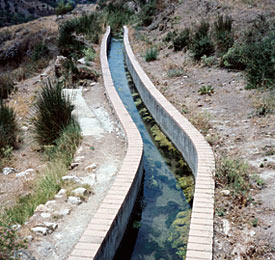 |
RICHARD COVINGTON
Flowing toward Granada from the spring in the village of Alfucar in the foothills of the Sierra Nevada, an acequia first built in the 13th century still flows today.
|
Although Islamic science is generally underrepresented in museums in the West, there is one standout exception: Granada’s Science Museum, which is constructing a major new wing dedicated to Arab contributions to world knowledge. Meanwhile, its smaller permanent exhibit, “Al-Andalus and Science,” offers one of the few introductions to Islamic hydraulics and agricultural innovation. (Another is at the Frankfurt Institute for the History of Arabic-Islamic Science.)
Alongside a model of a noria and miniature paintings of gardens is a bumper crop of exotic foods and commodities imported from Islamic countries to al-Andalus, including sugar-cane, cotton, rice, artichokes, eggplants (aubergines), spinach, citrus fruits, date palms and bananas. Such a cornucopia required highly organized irrigation to deliver a year-round water supply, one that employed qanats, minas (which resemble qanats, but without ventilating shafts) cimbras (ditches covered with slate slabs) and the man-made storage ponds called albercas, among other constructions.
One of the most mesmerizing exhibits is a small Plexiglas model of one of al-Jazari’s water-raising devices: a contraption with a paddle wheel activated by flowing water. The wheel turns meshing gears which rotate an axle that turns a vertical chain of buckets that pour water into an elevated courtyard fountain. Hill speculated that this whimsical fantasy was intended as a decorative lakeside attraction “with an element of mystification about it.” In the 13th century, a modified, full-sized version was erected on the Yazid River in Damascus; it raised water 12 meters (38') and directed it to a nearby hospital. The apparatus was used until 1960.
This is one of more than 50 water-raising machines, water clocks and other labor-saving hydro-automata that al-Jazari, among the most versatile inventors in the history of Arab science, presents in Al-Jami‘ Bayn al-‘Ilm w’ al-‘Amal al-Nafi‘ fi Sana‘at al-Hiyal (A Compendium on The Theory and Practice of the Mechanical Arts, also called The Book of Knowledge of Ingenious Mechanical Devices). His compendium includes colorful, minutely detailed illustrations. His designs for segmental gears, cranks, slot rods that convert rotary to reciprocating motion and suction pumps—some with double-acting, horizontally opposed pistons—all appeared some three centuries before they came up in the writings of Italian engineers.
Hill’s assessment of al-Jazari is categorical: “It is impossible to overemphasize the importance of al-Jazari’s work in the history of engineering.”
Yet like any genius, al-Jazari had his predecessors: Nearly four centuries earlier, in ninth-century Baghdad, the Banu Musa—the brothers Mohammed, Ahmed and al-Hassan, sons of Musa bin Shakir—drew on the work of their own Hellenistic predecessors Philon and Heron to devise fountains and trick vessels that replenished themselves using a variety of valves, siphons and floats. In the Kitab al-Hiyyal (Book of Ingenious Artifices), written around 830, the brothers conjure up more than 90 machines, some of which use convoluted, double-concentric siphons that create airlocks to regulate water flow.
In 16th-century Damascus, the polymath judge Taqi al-Din penned some 19 books on physics and hydraulics, including the intriguingly titled Al-Turuq al-Saniyya fi al-Alat al-Ruhaniyya (Sublime Methods of Spiritual Machines), an illustrated catalog written around 1551 that describes clocks, pumps, load-lifting equipment and other contrivances, including a water-powered six-cylinder “monobloc” pump. Its scoop paddlewheel turns an axle that sets cams and piston rods in motion, drawing water through a series of valves and accelerating it with great force into a delivery pipe. In the West, ironically, Agostino Ramelli, Italian physicist and author of the 1588 tome Le diverse et artificiose machine, received credit for devices Taqi al-Din had published 37 years earlier.
 |
DICK DOUGHTY
This larger acequia once helped bring water to the gardens of the Alhambra.
|
After exploring the hydraulic machines at Granada’s Science Museum, I drive across town to the city’s Nasrid-era Albaicín quarter to meet Carlos Vílchez, director of Granada’s Museum of Archae- ology and Ethnology and the author of a handsome volume detailing the city’s cisterns, wells, tunnels and waterworks. Eight hundred years ago, in this warren of densely packed, whitewashed houses in the heart of the old city, some 30,000 Spanish Muslims enjoyed running water, an efficient sewage system and 28 large, interconnected cisterns fed by shallow channels that brought spring water from a pool 12 kilometers (7½ mi) away in the foothills. Although these 13th-century aljibes were abandoned in the 1950’s with the introduction of a piped domestic water supply, the remote spring still functions as an auxiliary source of water for the city.“
Actually, the water from the spring tastes sweeter than the main supply from the Sierra Nevada mountains,” says Vílchez with a grin, when I meet him on Calle del Agua (Water Street) for a tour of the city’s medieval cisterns. Accompanied by Gracía Lopez of El Legado Andalusí, an influential cultural organization dedicated to spreading awareness of the Arab heritage in Spain, Vílchez leads me up the narrow, shop-lined lane, pausing periodically to inspect circular paving stones the size of saucers.“
See the holes and grooves?” he asks. “Those held the small ceramic sluice gates, the partidors that diverted water into individual houses and shops.” Beneath our feet is a maze of arched stone tunnels that channeled the spring water to various cisterns. Zigging and zagging past crowded markets that remind me of the suqs in Fez and Marrakech, we emerge into a quiet, sun-drenched square with a large niche in one wall where the residents lowered their buckets into the cistern to draw up water.
“This is the famous Aljibe del Gitane, the gypsy cistern, the one Federico García Lorca wrote about in ‘Romance Sonámbulo,’” says Vílchez reverently, as he launches without further ado into an impromptu recitation from the poem by Granada’s illustrious son:
Over the mouth of the cistern
The gypsy girl was swinging,
Green flesh, her hair green,
With eyes of cold silver.
Winding our way past the quarter’s well-preserved Moorish baths, Vílchez explains that updated archeological research has overturned the mistaken notion that the Muslims built baths, canals and aqueducts in Granada on Roman foundations.
“Their works were completely separate, erected in different locales,” he asserts. “Even the source of the water was directed into town from another village than the one the Romans used.”
Outside the 11th-century western wall of the Albaicín, we enter the Aljibe del Rey, the royal cistern, a recently renovated compound of courtyards, gardens and fountains above what is, hands-down, the largest aljibe in the city and, no doubt, one of the most impressive in the world. Carefully descending a shaky ladder into the empty cavern, we encounter a cool, echoing interior of lime-covered brick, 25 meters (80') square and four meters (13') high, a reservoir capable of storing some 300,000 liters (72,000 gal) of water. Originally, when the aljibe was constructed for the Nasrid Dynasty around the 13th century, it was open to the sky. Now it is covered by a vaulted roof supported by thick pillars and dotted with round and square holes that cast shafts of light into the shadowy recesses. Peering up near the roofline, I can see the small rectangular opening where residents used to gather to lower their buckets.
 |
TOR EIGELAND
Much resembling its counterparts in Spain, a narrow irrigation channel meanders through a grove in Oman. Some of Oman’s aflaj and other waterworks date back 2700 years; nationwide, such systems still deliver some 70 percent of the country’s water.
|
Back outside, as our eyes gradually adjust to the blazing sunlight, we climb into Vílchez’s car to have a look at La Fuente Grande, the big spring, the main source of water that once fed all of Granada’s aljibes, and that is now diverted into the city’s main reservoir. As the road climbs east past olive groves, we turn into a regional nature preserve, the Parque de Sierra del Huétor. We stop briefly to admire the acequias, the slender aqueducts that meander downhill into Granada.
“The 13th-century engineers were incredibly accurate surveyors,” marvels Vílchez, “able to incline these canals so that the water moved neither too fast, which would cause overflowing, nor too slowly, which would make it stagnate.” Although the distance to town is 12 kilometers (7½ mi), the canals cross farmlands and olive groves, so their actual length is close to three times as long, he says. Farmers in Valencia province to the north and also in the Alpujarras mountains south of Granada still use open-air, Islamic acequias for irrigation, Vílchez remarks.
It is at the village of Alfucar, surrounded by lofty pine trees and scrub brush, that the spring itself bubbles forth into a tear-shaped pool of invitingly pellucid water, vivid green lichens waving in the bottom. Sweeping an arm toward the scree-covered hills above us, Vílchez explains that rainwater filters into the aquifer from the mountains and surges up in a continuous flowing volume that to the Muslim settlers, accustomed to drier climes, appeared nothing short of miraculous.“
The Berbers and Arabs were absolutely astonished at the amount of water available here,” he muses, gazing across at the parched landscape. “So they took advantage of the abundance.”
 |
Paris-based author Richard Covington writes about culture, history and science for Smithsonian, The International Herald Tribune, U.S. News & World Report and the London Sunday Times. His e-mail is richardpeacecovington@yahoo.com.
|